Contrarian Spectrum News in Major Papers
Last week the New York Times had an article entitled “Carriers Warn of Crisis in Mobile Spectrum”. It included the video above as well as the photo and caption at left, so you know that it presented several viewpoints. NAB’s Dennis Wharton was so excited about it that he sent it out with the following introduction:
To reporters who follow "spectrum crunch" stories:
I thought you might find of interest this article from The New York Times that quotes cellphone inventor Martin Cooper questioning wireless carriers' claims of a "spectrum crisis." Cooper says that wireless carriers are exaggerating their need for more spectrum and newer technologies can ease the demand for airwaves.
Cooper's statements follow others who are questioning the "spectrum crisis" notion in media outlets such as GigaOM and DSL Reports, as well as others who have proposed solutions wireless carriers can adopt to resolve network congestion issues. Last April, former FCC official Uzoma Onyeije released a paper detailing many of the same alternate solutions Cooper provides for wireless carriers to alleviate mobile broadband congestion.
Oddly, Mr. Wharton did not send me a copy of today’s Washington Post article entitled in the print edition “Regulators debate the future of broadcast” and on the website “As users flock to iTunes, Hulu and Netflix, TV stations struggle to survive”. The article starts off,
As the audience for free television fades, federal regulators are wrestling over the future of the government-mandated broadcasts, which were originally intended to knit the nation’s disparate communities together.
Today, only 10 percent of the nation relies on free, over-the-air TV, which was created by the Telecom Act in the 1930s. To get a license, broadcasters had to offer local, educational and political programming, and to make it widely available to rich and poor alike...
And as fewer people rely only on broadcast television, stations around the nation are struggling to survive even as some rural residents, elderly and the poor continue to rely on free TV..
(The Post included a “photo gallery” with their article, but did not provide embedding code like NYT did.)
I am puzzled why the Post’s Ms. Kang, who usually writes knowledgeably about FCC uses the phrase “federal regulators are wrestling”, when the reality is that they are trying as hard as they can to avoid the issue. Readers may recall my January post here about the quote from Justice Alito:
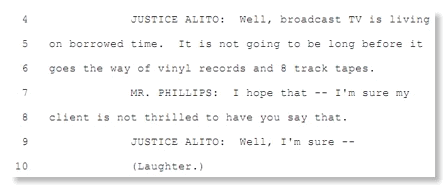
The truth in both cases is that official Washington is spending far to much time kowtowing to the alarmist and conflicting demands of BOTH NAB and CTIA.
The Times and Post articles are rare breaths of fresh air that one rarely hears from our government officials, Justice Alito excepted.
Adaptrum TV White Space Unit Approved
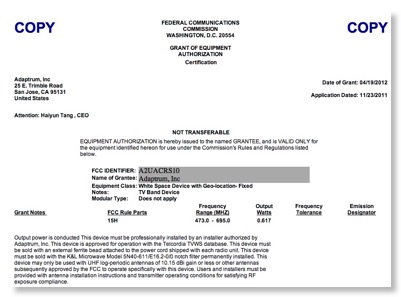
On April 19, the traditional Patriot’s Day in my home state of Massachusetts and the anniversary of the “shot heard round the world” that started the American Revolution, FCC approved the equipment authorization application of Adaptrum, Inc. for a TV white space device for unlicensed use in the UHF-TV band under the rules adopted in Docket 04-186.
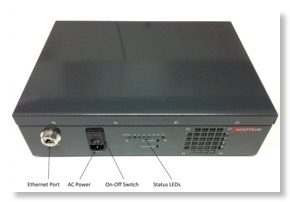
Adaptrum ACRS 1.0 White Space Device
The unit was approved as shown above for the frequency range 473.0 - 695.0 MHz, TV channel 14-51, and a transmitter power of 0.617 W. The approval include permission for use of antennas with a gain up to 10.15 dBi, so the device is capable of the maximum 36 dBm, almost 10 dB higher than the only other device that has ever been approved.
Adaptrum also announced a field test of its equipment in rural Nottoway County Virginia. This is an economically challenged area with little broadband connectivity due to disinterest of the mainstream carriers and lack of appropriate technical options in the past. Adaptrum hopes to show how white space technology can improved connectivity in such an area.
Adaptrum, founded in Silicon Valley in 2005, is MSS’ oldest client and we are proud to have played in a key role in assisting them to reach this point.
Adaptrum press release
Titanic & Spectrum Policy
On this anniversary of the sinking of the RMS Titanic, let us recall that modern spectrum policy really stems from this event.
Prior to this disaster, there was little international or national regulation of radio. The chaos associated with the Titanic’s distress call and the resulting loss of life brought urgent attention to the issue. A key question is whether this basic framework needs to be addressed every 100 years? Even though we have just finished WRC-12, the difficulty over GPS/LightSquared and the question of what is “harmful interference” shows there are some basic flaws. While some might want to politicize the GPS/LS controversy, I believe the root cause was regulatory uncertainty which does no one any good.
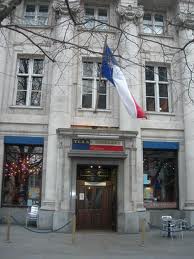
(There actually was a Texas Legation in London from 1836 through 1845 in a building not too far away)
Belgian Comedy Group Strikes Back at Poor Cellular Company Customer Service

Here is a description of what happened from funcrunch.com
Everyone of us who enjoys having that magical gadget cell phone with him or her has gone through the exercise of calling to a mobile phone company like Mobistar and the response is same at every company; if you need this press that, if you need that press this, if you need to talk press this, if you need to write press that, and so on with endless musical intervals that make you so irritated that you do not want to listen to that kind of music in your daily life as it reminds you of the irritation that was caused by the mobile phone company while putting you on a hold.
Guys from VRT Belgium turned the tables on Belgium’s much reviled company Mobistar when they played a practical prank by putting a steel container in the gates of the Mobistar at 5 AM on 22 December. The staff comprising of three and camera crew was inside the container to take the calls from the bothered Mobistar employees.
Then begins the long episode of the replication of what companies like Mobistar do to their customers. If you need to accept these containers press this and if you need to reject this container press that and so on. They guys kept the prank well above three hours while 2000 Mobistar employes were lining in their vehicles waiting for the disposal of the container.
The YouTube video at the top of this post has subtitles of the interaction between the pranksters and Mobistar.
Hopefully US cellular carriers are not as bad as Mobistar, although all of us have stories about odd interactions with customer service of telecom firms. SpectrumTalk does not endorse the actions of Basta shown in this video.
FCC & Cell Industry Address Stolen Phone Problem At Last!
Visit msnbc.com for breaking news, world news, and news about the economy
This morning Chmn. Genachowski joined with several law enforcement and government leaders as well as CTIA’s Christopher Guttman-McCabe “to unveil new Initiatives to protect consumers and curb smartphone device and data theft”.
Readers may recall 2 earlier posts that discussed this problem following the bizarre appearance of CTIA’s John Walls on the Today Show, where he seemed oblivious to the issue of taking quick action to discourage thefts through blocking the reregistration of stolen phones as is done in Australia and UK. While CTIA claims the interview was unfairly edited, a responsive YouTube post by Mr. Walls the same day still showed disinterest in the topic and a desire to wait until consensus was reached on details with “Mexican service providers, Central American, South America, African, Chinese”.
While the details of the new FCC plan are not yet posted, a video of the event should be available soon on the FCC website.
Wireless Week reports
Kudos to the cellular industry for digging themselves out of the self-inflicted PR problem they got themselves into on March 22 and agreeing to promptly take initial actions to discourage violent thefts of their equipment that endanger their customers.There are a number of facets to the initiative. Wireless carriers, in conjunction with law enforcement, CTIA and the FCC, will implement databases to prevent reactivation of stolen smartphones. By October 2012, U.S. GSM providers will implement a database so that stolen GSM smartphones will not work on any U.S. GSM network.
In addition, U.S. providers will create a common database for LTE smartphones designed to prevent smartphones that are reported stolen by consumers from being activated or provided service on any LTE network in the U.S. and on appropriate international LTE stolen mobile smartphone databases. That database will be completed by Nov. 30, 2013.
FCC & The GSA Scandal
You probably have read more than you ever wanted to know about the recent GSA Las Vegas conference scandal. For those who have been on Mars for the past week, USA Today reports
General Services Administration is resigning and two top aides have been fired over an $835,000 training conference in Las Vegas that included a mind reader and commemorative coins.
"The president was informed before his trip to South Korea, and he was outraged by the excessive spending, questionable dealings with contractors and disregard for taxpayer dollars," said White House chief of staff Jack Lew.
Obama "called for all those responsible to be held fully accountable given that these actions were irresponsible and entirely inconsistent with the expectations that he has set as president," Lew said.
However, there are indications that these lavish conferences may have begun under Bush 43:
The Obama administration has come out and criticized the shocking spending and is now pointing the finger at the Bush administration for the problem. A White House official has said that in 2004, the conference cost $93,000; in 2006, the cost had ballooned to $323, 855; and by 2008, it hit $655, 025.
So what is the FCC connection?
- Robert Peck, until recently Commissioners of the Public Building Service mysteriously worked in the Office of the Managing Director in the past where he bore much of the brunt of the Republican criticism of the Portals selection for FCC’s current lease
- This scandal was uncovered by GSA’s Inspector General. FCC leadership, under all recent chairmen, need not fear such sleuthing since the FCC Inspector General constantly ignores his statutory charter and focuses on issues that couldn’t embarrass the “8th Floor”.
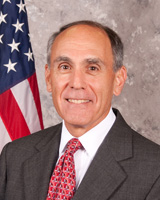
Robert A. Peck serves as the Commissioner of Public Buildings for GSA. He was appointed to this position on August 19, 2009.As Commissioner, Peck is responsible for the nationwide asset management, design, construction, leasing, building management and disposal for 375 million square feet of government-owned and leased space, accommodating 1.1 million federal workers. Additionally, he oversees annual revenue of more than $9.4 billion and a workforce of 6,750.
Most recently, Peck served as a managing director of Jones Lang LaSalle, where he advised corporations, governments, and nonprofit institutions on real estate portfolio strategy and on public-private, mixed-use developments. He previously served as Commissioner of Public Buildings during the Clinton administration.
His prior federal experience includes positions at the Office of Management and Budget, the National Endowment for the Arts, and the Federal Communications Commission. On the U.S. Senate staff, he was associate counsel to the Committee on Environment and Public Works and Chief of Staff to the late U.S. Senator Daniel Patrick Moynihan. He has also been a land-use and real estate lawyer, president of the Greater Washington Board of Trade and vice president for public affairs at the American Institute of Architects.
Peck served as a Special Forces officer in the U.S. Army Reserve. He is a past president of the D.C. Preservation League, a former appointee to the D.C. Board of Education and has served on numerous other public and nonprofit boards.
Peck holds a bachelor’s degree in economics from the University of Pennsylvania, a Juris Doctor from Yale Law School and was a Visiting Loeb Fellow at Harvard University’s Graduate School of Design.
The FCC website search engine has no information on Mr. Peck, perhaps because his service at FCC was in the early Hundt Chairmanship when the website was just coming into creation. (FCC alums recall that Hundt’s predecessor brought FCC touch tone phones to replace dial ones and a desktop computer system using VT-100 “smart terminal” clones that was obsolete upon arrival.) I recall speaking with Peck several times when he mysteriously came from The Hill to take a top job in the Managing Director’s Office. He seemed like a nice enough guy who asked a lot of good questions about FCC, although I can’t recall what topic I was working with him on.
The Republican criticism of the FCC Portals move often includes Peck as a bad guy as shown in this article from our local right wing free newspaper. However, when I was in the former Field Operations Bureau, now Enforcement Bureau, the most secret project I ever saw was covert measurements of new location for FCC headquarters that were made at the direction of the Chairman’s Office - involving multiple chairmen from both parties. The purpose of these measurements was to use FOB’s minimal radio monitoring capability at headquarters as an excuse to eliminate certain sites and favor others. So one had to know the spectrum characteristics of each site in order to “tilt” the RFP to favor/disfavor certain ones. This was a bipartisan game during the near 2 decade search for a new site after the Rosslyn site (later leased to USA Today, which has since moved elsewhere) went down during the early Reagan Administration.
Mr. Peck was an example of politically connected people who were cycled through high FCC management positions to groom them for higher positions in other agencies. This has also been a bipartisan practice at “independent” FCC to do such favors for whoever is in the White House and has further muddied FCC management capability and the lowered the morale of well motivated career civil servants.
On the 2nd point, readers may recall that the dismal state of the FCC Inspector General’s office for the past decade or so has been a recurring theme. The GSA scandal was uncovered by GSA’s Inspector General. Both the GSA IG and FCC’s IG have the same exact basic responsibility: They are both obligated by 5 USC App. 4(a)(2)
to review existing and proposed legislation and regulations relating to programs and operations of such establishment and to make recommendations in the semiannual reports required by section 5 (a) concerning the impact of such legislation or regulations on the economy and efficiency in the administration of programs and operations administered or financed by such establishment...
The only difference is that the FCC IG is appointed by the Commission upon recommendation by the Chairman and the GSA IG, like most major agency IGs is appointed by the President with Senate confirmation. But the obligations are the same.
While the current FCC IG is not an 8th Floor intimate like all his predecessors, he has chosen to continue their practice of focusing almost entirely on external fraud issues involving the Universal Service Fund that are within his charter and avoiding issues of internal FCC operations that would appear to be required by 5 USC App. 4(a)(2) but which might be embarrassing to the 8th Floor. Thus do not expect any IG reports on what were the root causes of the GPS/LightSquared flap or the Channel 51 controversy. A functional IG could help FCC learn from the past, but this seems unlikely to happen soon. So if FCC had a GSA-like scandal, the FCC IG would never be the one to reveal it. (Actually, FCC discretionary appropriation - the amount in excess of fixed costs such as salaries and rent -is so small that FCC could never spend as much money as GSA did.)
| The Daily Show with Jon Stewart | Mon - Thurs 11p / 10c | |||
| GSA-holes | ||||
| ||||
FCC's Ambivalent Views on Equipment Enforcement

Last week I gave an invited talk at the American Council of Independent Laboratories” (ACIL) 2012 Policies & Practices Conference. ACIL is the trade organization that represents private testing labs including the ones active in the FCC’s equipment authorization program, which FCC describes as
“The FCC oversees the authorization of equipment using the radio frequency spectrum. These devices may not be imported and/or marketed until they have shown compliance with the technical standards specified by the commission.”
The talk was entitled “Enforcement in the Digital Age”. Readers may recall that equipment marketing enforcement has been a recurring theme in this blog. While FCC sometimes lashes out with dramatic equipment marketing enforcement actions, in general FCC seems to turn a blind eye to such enforcement issues, relying almost exclusively on a complaint-driven process. FCC bureaucrats have learned that enforcement usually makes somebody angry, the perpetrator, who then hires a big law firm. Unless there is somebody who is pleased by the enforcement, a big complainant for example, the principle of “aggravation minimization” dictates don’t get involved.
Oddly, the major trade associations, NAB, CTIA, TIA, and CEA, seem to have little or no interest in equipment enforcement, except perhaps for the case of jammers. As a result there is essentially no independent surveillance of marketing of noncompliant equipment other than the recent (long overdue) initiative on cellular and GPS jammers. Enforcement Bureau staffers do not spot check retailers for noncompliant equipment. They don’t even go to the annual Consumer Electronics Show. There is a small amount of market surveillance by TCBs, but, as discussed in slides 16-17 this is minimal and hopelessly affected by intrinsic conflicts of interest.
The FCC Lab does not routinely call in equipment for post approval testing or ask manufacturers for copies of test data for equipment subject to Verification or Declaration of Conformity. During my tenure such events were very rare and may well continue to be very rare. Indeed, as I pointed out in my talk (slide 18 ), the labels on equipment subject to Verification or Declaration of Conformity do not necessarily contain enough information to even identify who the “responsible party” is that is supposed to have the test data. This if a suspicious unit were to be bought at a retailer - another unlikely event - it can be difficult to trace the source under present rules.

The issue of “lab queens” was discussed (Slide 15). “Lab queens” does not refer to the possible life style of FCC employees, rather it refers to test samples of equipment that are atypical of the actual production equipment. This could result from either testing many units and selecting the one with the best performance or by intentionally modifying a production, for example to decrease its power. This actually happens and so far has never resulted in a major penalty. I proposed criminalizing this behavior by requiring a sworn affidavit from a US resident stating that the unit was normal production unit taken from normal inventory. Further I proposed that FCC be authorized to request a “coupon” good for a unit of equipment at any retail dealer. This would allow FCC for the first time to get reliable samples of production equipment for sampling.
I pointed out that FCC keeps saying that it will modify its rules quickly when new types of equipment-related interference are actually encountered. This is just not credible. In the case of police radar detector interference to VSAT systems it took over 10 years for FCC to react. In the ongoing case of interference from early generation bidirectional cellular amplifiers if has taken more than 5 years and there still is no action so marginal manufacturers can still make the original designs although reputable manufacturers have eliminated the problem through design changes. I urged a regular public report on “emerging interference issues” which are not even well disseminated within FCC staff at present. (Slides 9-10)
Presently unregulated amplified
TV antenna with 55dB gain!
I ended the presentation with an open question: why do the major trade associations with an apparent interest in orderly spectrum use (CTIA, NAB, TIA, CEA) remain so silent on the issue? Is reasonable progress possible?
CommLawBlog Uncovers Secretive FCC Program "to correct the rampant problem of high tech know-nothingism"
In a post on April 1, 2012, CommLawBlog revealed that FCC is at last “the Commission is taking aggressive steps to correct the rampant problem of high tech know-nothingism.”
In their exclusive scoop CommLawBlog reported,
“It seems that Nationwide Online Information Tracking and Logistics System (NOITALS) enables the Commission to see what’s going on in each individual computer, nationwide, without the intervention of the computer’s user.Details are scarce, but from what the FCC says, NOITALS gives the Commission real-time access to all activities of any Internet-connected computer (or mobile device) when its Internet connection is operational, including (but not necessarily limited to) all details relevant to its access to the Internet. Think websites visited, searches conducted, emails sent, etc.”
We are chagrined that we missed this key news. We promise readers that next April 1, we will keep a keen eye out for such news so we can scoop CommLawBlog.
In other news of April 1, here is an exciting new service announcement from WestJet, a Canadian airline we actually used recently. They are now offering flights without children in the cabin to disturb adult passengers. What a great idea!





![Validate my RSS feed [Valid RSS]](valid-rss-rogers.png)

